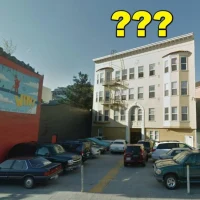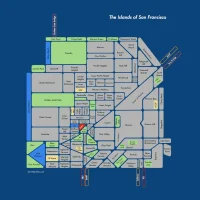Skeletons Beneath Our Feet
You may have heard that a skeleton was found at the Transbay Terminal construction site, 60 feet down. “The agency said its archaeologists worked in coordination with the San Francisco coroner’s office and determined that the remains are of Native American descent.” 60 feet down is pretty old, especially when you consider that in the 1840s when Yerba Buena started booming, First Street once bordered the water.
How old? Well, in 1969, construction workers digging out BART found a skeleton 75 feet below Civic Center. Turns out it was nearly 5000 years old.
The top half of the skeleton was lost during construction, but from the remaining half archaeologists determined that it was a 24-26 year old female who may have drowned in a creek. @davely was kind enough to scan an 1972 article from California Geology journal which had this diagram:
I took the liberty of redrawing the diagram in color, and stretching the vertical axis for clarity.
Archaeologists found both fresh and salt-water plant matter attached to the skeleton, indicating that our friend may have died in a creek or a marsh near the shore. She was found 26 feet below current sea level, which implies that sea level 5000 years ago was around that level.
San Francisco Bay as we know it is relatively new — as the ice age ended, sea levels rose dramatically. 18,000 years ago, to get to the beach you would need to take the N-Judah or the K past the Farallons, which were once hills by the sea. The Bay was a valley with a river running through it, and the Golden Gate was a waterfall.
Doris Sloan, Geology of the San Francisco Bay Region
San Francisco would have been Walnut Creek.
But as the waters rose the Farallons were cut off.
map via Late Pleistocene to Holocene History of San Francisco Bay, Prof. Lynn Ingram, UC Berkeley
These once were hills, separated only by sand dunes.
Around 10,000 years ago, the sea breeched the Golden Gate and continued to rise rapidly, filling the valley we now know as San Francisco Bay. There must have been settlements by the water — imagine each generation having to pull back, each high tide greater than the last.
In 1818, a Spanish missionary recorded some of the oral traditions of the Ohlone and neighboring tribes. One story went like this:
“What is now the port of San Francisco was formerly according to the tradition of the old ones an oak grove, and without water other than of a river that crossed at its foot, and in evidence of this tradition, they say you still find in the port and marsh, trunks and roots of oak trees.”
However, no known archeological site in central California appears much older than 5,000 years… One way to approach this problem is to assume that traces of the earliest central Californians have been covered by the rising sea. Given the rapidity of changes in sea levels and shorelines 5,000-10,000 years ago, sites of habitation located at that time along the shores of estuaries must now lie beneath mud and tidal water.
He asks:
How old, then, is the aboriginal tradition recorded by Mariano Payeras? If originated by people who actually saw the site of the Bay before widespread submergence, this tradition must be nearly 10,000 years old. Such antiquity, though improbable, cannot be ruled out.
Perhaps one day 10,000 years from now, archaeologists will find and decode flash memory that will reveal this map.
(Hi future archaeologists! Hope you extended BART and still have burritos.)














Awesome post, as always.
Even creepier, FULTON AND LEAVENWORTH NO LONGER MEET.
Ten bucks says the Ohlone bitched about the N-Judah. “For fuck’s sake, I’m going to be late getting to the shell midden AGAIN”
“archaeologists will find and decode flash memory that will reveal this map.”
I hope this is meant to imply that you are copying the map onto flash/USB drives and burying them in random sites around SF.
By the way: “San Francisco would have been Walnut Creek” is a truly horrifying statement that I never, ever want to hear repeated.
See any Walnuts? See any Creeks?
VERY interesting… Reminds me of the first portions of Erica J. Peters’s book on SF food history, starting with the bountiful sea.
Reblogged this on The Rockstar Anthropologist and commented:
5000 Year Old Native American Skeleton Found in San Fran…
Amazing image in my mind of a massive waterfall at the Golden Gate.